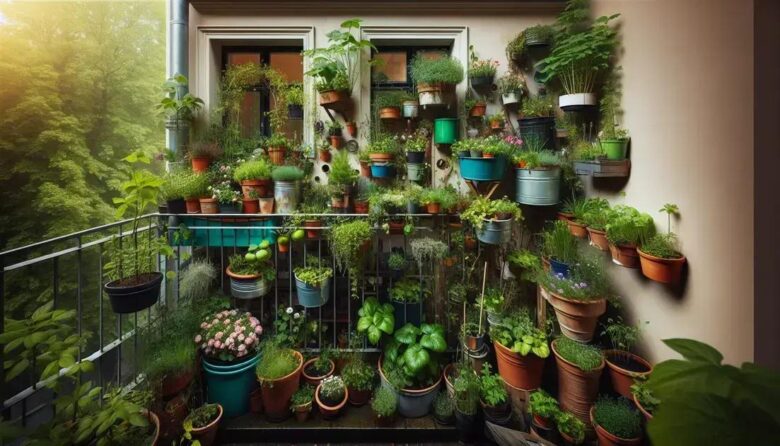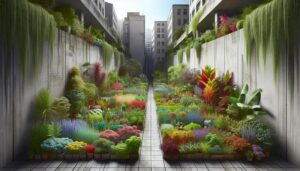Transforming a balcony into a permaculture garden optimizes limited space using vertical planting, companion plants, and sustainable practices like composting and natural pest control to create a self-sustaining urban ecosystem.
Permaculture on a balcony can turn your urban space into a green haven. Ever thought how feasible it is with recycled bins? Let’s explore practical steps to create a sustainable ecosystem right at home.
understanding permaculture basics for beginners
Permaculture is a sustainable design philosophy that works with nature to produce food and other resources while conserving energy and resources. At its core, permaculture involves observing natural ecosystems, identifying patterns, and using those patterns to inform human activities. This approach minimizes waste and maximizes productivity while respecting all life forms.
Core Principles
One of the central principles of permaculture is observing and interacting with natural environments. This involves spending time understanding how different elements interact and influence each other. Another key principle is catch and store energy, where resources like water and sunlight are harnessed and preserved for future use.
Designing Your Space
Elements analysis is crucial. This involves evaluating what exists in your environment—like sunlight exposure, wind patterns, and available water sources—and using these factors to plan your layout. A zone planning helps to categorize your space for different purposes based on proximity and use frequency.
Applying these principles on a balcony requires creative use of vertical space and smart resource management. With limited space, it’s essential to integrate functions—for instance, using recycled bins to create planters that hold multiple types of plants, sharing resources like water and sunlight effectively.
choosing the right recycled bins for planting
When selecting recycled bins for planting, it’s important to consider both functionality and sustainability. Start by assessing the materials available at hand. Common options include plastic containers, metal cans, and even old wooden crates. Ensure the materials are sturdy enough to hold soil and plants while being safe for growing edibles.
Size and Depth Considerations
Different plants have different root depth requirements. Shallower bins are ideal for herbs and leafy greens, while deeper containers are necessary for root vegetables like carrots and potatoes. Consider the eventual height and spread of the plants when choosing the right bin size.
Drainage Solutions
Proper drainage is vital to prevent root rot. Ensure each bin has adequate drainage holes. Adding a layer of gravel or small rocks at the bottom can help water flow out smoothly. Recycled bins without drainage can be modified easily with a drill, allowing customization for various plants.
While selecting your bins, think about placement on your balcony. The material will affect its weight when filled with soil. Lighter bins are easier to move around, allowing you to take advantage of the best lighting conditions throughout the year.
With thoughtful selection and some creativity, recycled bins can be transformed into efficient planting containers that promote both growth and sustainability.
setting up a balcony permaculture garden
Transforming your balcony into a permaculture garden is an exciting way to embrace sustainable living. Start by evaluating the light and wind conditions of your space. South-facing balconies typically receive more sunlight, ideal for a diverse plant mix.
Organize your space using zones, placing frequently used plants like herbs and greens closer to your kitchen door. Use vertical solutions like shelves and trellises to maximize planting areas and create layers. This not only helps with space management but also promotes biodiversity.
Choose plants based on their natural companions. Companion planting enhances growth and repels pests naturally. For example, planting basil with tomatoes can enhance flavors and health.
Consider setting up a small composting system using kitchen scraps to create nutrient-rich soil. This reduces waste and provides a sustainable feeding solution for your plants.
Water management is crucial, so install a rainwater collection setup if possible, or use efficient watering techniques like drip irrigation to conserve water.
Engaging with your permaculture garden daily fosters a deeper connection to your food source and teaches valuable lessons in sustainability.
essential plants for balcony permaculture
Choosing the right plants for a balcony permaculture garden is crucial for creating a thriving ecosystem. Start with herbs like basil, mint, and parsley, which are easy to grow and useful in the kitchen. These plants do well in containers and can tolerate varying light conditions.
Leafy greens such as lettuce, kale, and spinach are also excellent choices. They grow quickly and can be harvested multiple times. These greens are suitable for small spaces and can be grown in shallow bins.
For those looking to add color and pollinator attraction, consider flowering plants like marigolds and nasturtiums. These flowers not only beautify the balcony, but they are also known for their pest-repellent properties.
Tomatoes, peppers, and cucumbers are great fruity vegetables to grow on a balcony. They require larger containers and sunny spots to thrive but provide bountiful yields.
Don’t forget to include some root crops like radishes and carrots if space allows. These can be grown in deeper bins and contribute to soil health by promoting aeration.
A successful balcony permaculture garden relies on a diverse range of plants that fulfill different roles in the ecosystem, offering both beauty and utility.
maintaining your balcony ecosystem
Maintaining a healthy balcony ecosystem involves regular care and observation. Start by establishing a consistent watering schedule based on the needs of your plants and climate conditions. Using a drip irrigation system can ensure plants receive the right amount of water without excess.
Regular pruning and trimming are vital to control growth and encourage new shoots. Removing dead or yellowing leaves prevents disease and allows plants to focus energy on new growth.
Monitoring for pests is crucial in a small space. Regularly inspect plants for any signs of infestation like holes, discoloration, or wilting. Natural solutions such as neem oil or introducing beneficial insects can help maintain balance without chemicals.
The health of your ecosystem also depends on the quality of soil. Amend soil with compost regularly to replenish nutrients. This not only feeds the plants but also supports beneficial microbial life that keeps the system harmonious.
Rotating crops is another strategy to prevent nutrient depletion and control pests. By changing plant locations between seasons, you maintain soil health and encourage varied growth.
common challenges and how to overcome them
Building a balcony permaculture garden can come with its own set of challenges. One common issue is space limitations. Maximize vertical space by using hanging pots or shelves to grow a variety of plants. Consider using trellises for climbing plants like cucumbers or beans.
Pests can be another challenge. Natural pest control methods include introducing ladybugs to eat aphids or using neem oil to deter unwanted insects. Maintaining plant health through good soil and proper watering also helps prevent infestations.
Another difficulty is dealing with limited sunlight. Select shade-tolerant plants if your balcony doesn’t get much sun. Reflective surfaces can help maximize available light, and rotating plants can ensure they all get adequate exposure.
Managing water, particularly excessive rain or drought, can also be tough. Ensure proper drainage by using containers with holes and consider a drip irrigation system for consistent watering. During rain, use plant covers to protect against overwatering.
Lastly, maintaining soil health is vital. Regularly incorporate organic matter like compost to keep soil nutrient-rich and pH-balanced. Testing soil occasionally can also guide necessary adjustments in your care routine.
Embrace a Green Future on Your Balcony
Creating a permaculture garden on your balcony is not just possible, it’s rewarding. With the right plants, recycled bins, and sustainable practices, you can transform a small space into a lush, self-sustaining ecosystem.
Addressing challenges with innovative solutions can turn potential obstacles into learning experiences. Whether it’s finding the right light, managing pests, or optimizing space, your balcony garden is a testament to adaptability and creativity.
By nurturing this miniature ecosystem, you’re contributing to a greener future and enjoying the beauty and bounty of nature at your doorstep. Take the first step today and watch your balcony come alive.
FAQ – Common Questions About Balcony Permaculture Gardening
What is permaculture, and how is it applied on a balcony?
Permaculture is a sustainable gardening approach that mimics natural ecosystems. On a balcony, it involves using space efficiently to grow plants that benefit each other.
Which plants are best for a balcony permaculture garden?
Herbs like basil and mint, leafy greens such as lettuce, and flowering plants like marigolds are all great choices. They thrive in containers and have multiple uses.
How can I maximize space in a small balcony garden?
Utilize vertical space with shelves and hanging pots. Consider using trellises for climbing plants and organizing plants into zones for efficient use of space.
What natural pest control methods can I use?
Introduce beneficial insects like ladybugs, use neem oil, and ensure plant health through good soil and watering practices to deter pests naturally.
How can I improve soil health on my balcony?
Add compost to replenish nutrients and maintain pH balance. Regularly amending soil with organic matter supports plant growth and ecosystem health.
How do I deal with limited sunlight on my balcony?
Choose shade-tolerant plants and use reflective surfaces to maximize light. Rotate plants to ensure each gets adequate exposure throughout the day.



